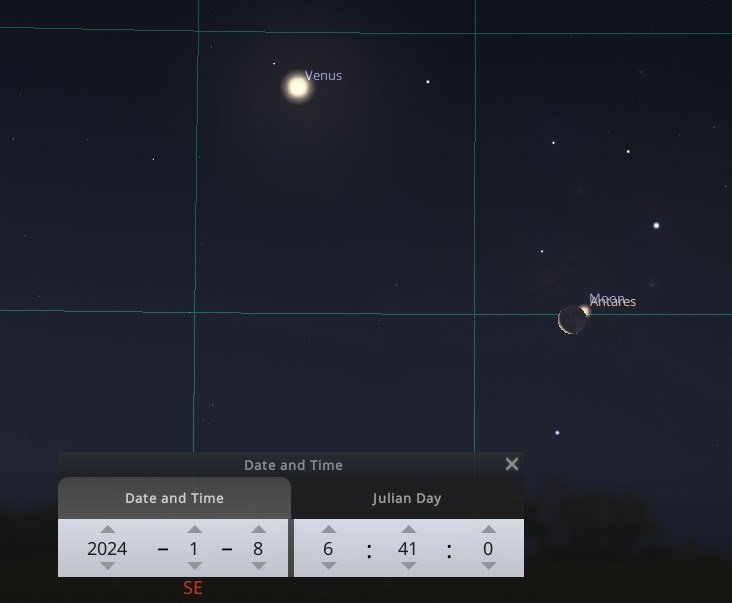This month’s article is a week early – presumably, Dec. 22 – to allow the Coast Reporter to do their year-end review on Dec. 29, which precludes running my usual last-Friday-of-the-month stuff. Coincidentally, yesterday – December 21 – was the occasion of the winter solstice at 19:27, or 7:27 p.m. As of yesterday, the days are getting longer. It also means I can cover the very neat series of Space Station (ISS) passes in late December that continue through early January. Astro-nerds, rejoice!
The morning passes of the ISS are a series of early so-so ones followed by bright ones generally between 06:30 and 07:30. The passes at the end of the year are bright but the morning pass on Jan. 1 is special; at about 06:17, the station comes out of Earth’s shadow in Leo near Regulus, then moves east and passes just above the Moon, passing Venus three minutes later and setting in the southeast. Remember, the Space Station was launched from Baikonur in Kazakhstan at latitude 51 degrees north and its orbit keeps that 51 degree tilt to Earth’s equator. So, if you’re in Calgary or London (both 51 degrees north) it can rise in the west, pass directly overhead and set in the east. It moves in the same direction as the Earth turns and the moon revolves, but faster. Because of the unpredictable drag from Earth’s thin exospheric atmosphere, the station loses energy, its orbit slowly decays and NASA regularly boosts it back up to its target altitude. Consequently, predictions for its passes are only accurate for a week or two. The Heavens-Above website has the best info on these.
The Quadrantid meteor shower occurs every January and this year its predicted peak occurs after midnight on Jan. 4. The last quarter Moon rises at 01:00 so the best chance of seeing these meteors is before the Moon washes out the faint ones. That radiant is above the horizon all night so we’ve got a good shot at meteors before midnight although the peak of the Quadrantids is fairly narrow, only about 12 hours or so. The radiant is the point in the sky from which the meteors appear to come; for the Quadrantids it’s a bit left of the free end of the Big Dipper’s handle. Since it’s so high in the north, we’ve got a much better view than people farther south or Down Under, for example. As with all showers, just find a warm comfortable place to lie down under an open sky and look up. While the meteors will appear to radiate from the handle, they can appear anywhere in the sky.
The Geminid shower of December (we were clouded out) is one of the more populous we see with a Zenithal Hourly Rate of 120. The Quadrantids have similar numbers but apparently a completely different source or sources. While the Geminids originate from a rocky body - the asteroid 3200 Phaethon – the Quadrantids seem to be associated with at least two bodies, the first an asteroid named 2003 EH1. It’s believed to be a dormant or extinct comet, according to the late comet expert Don Macholz. However, I’ve also read that “there is also a second, related object that also contributes to this meteor shower. The second object – Comet 96P/Machholz – produces a less intense and shallower peak.” Yup, named after the same guy. The mystery isn’t solved yet though; neither object crosses Earth’s orbit now although they may have in the past.
Mercury makes an appearance in the morning sky in January as well. Its best visibility is about 07:00, before sunrise in the southeast near Venus and about 5 degrees above the horizon for the first two weeks of January. Definitely the prettiest view will be on Jan. 8, when Mercury and Venus are joined by a waning crescent Moon, but earlier that morning at around 06:39, the Moon which is moving down and to the left relative to the stars, moves out from in front of Antares, the brightest star in Scorpio. This sort of occultation is pretty spectacular, since Antares will reappear from behind the dark limb of the Moon, blinking in like someone turned on the light! If anyone knows any effective prayers, voodoo or whatever to get us a clear sky, this would be an ideal time to use them.
The SCAC monthly meeting will be at the Sechelt Library at 7:00 pm, Jan. 12, at which The Sky This Month will be presented. Please check the club website at: https://sunshinecoastastronomy.wordpress.com/ for the subject of the guest lecture. Non-member admission will be by donation and refreshments should include coffee and cookies.



.png;w=120;h=80;mode=crop)
